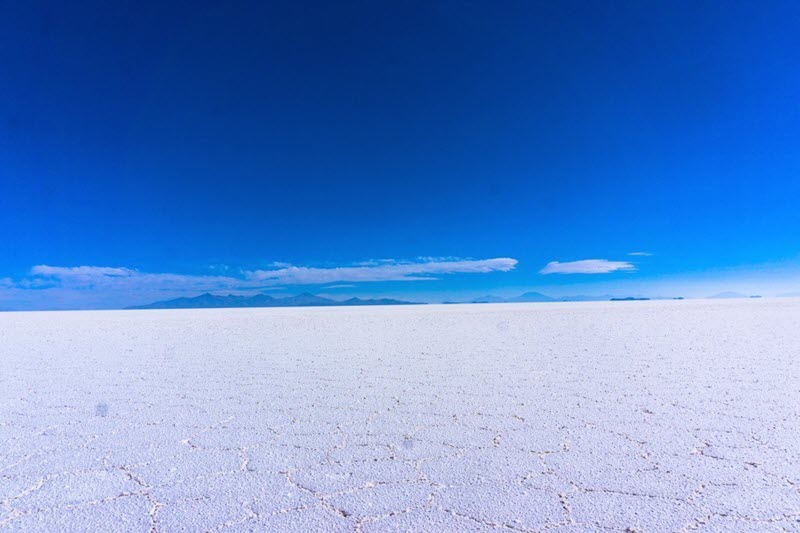대구외고 2학년 기말고사 대비(The Rush for White Gold-4)
대한민국 1% 영어강사, 찍신 이상엽 쌤은 내신과 수능에 최적화된 실전문제를 제공합니다. 이상엽 쌤은 대구외고 수험생들을 위해 선생님들의 출제경향을 정확히 분석해 맞춤예상 문제를 제공합니다. 본 문제에 대한 궁금한 점 또는 영어가 어렵고 고민이면, 010-2818-6994로 연락주세요.
[12~22] 다음 글을 읽고, 물음에 답하시오.
[E] It takes a day to drive from the world’s highest capital city to the world’s largest salt flat. The route passes steadily downhill through small villages, until leveling out, at about 3,600 meters, into a mostly vacant stretch of land occasionally animated by llamas. By late afternoon, the salt flat can be seen across the plain.
[F] I reach the Salar—Spanish for “salt flat”—just before sunset, and for over a kilometer I drive along its smooth and firm surface until it becomes evident that this is the middle of nowhere. The spectacle seems unreal: kilometers of whitewashed level terrain, its starkness perfected by the cloudless blue sky and the Andean peaks in the distance. Motorcycles and 4x4s drive across the roadless surface, destinations unknown. Here and there solitary people wander about, gazing into what the Bolivian vice president calls “the infinite table of snowy white.”
[G] Somewhere out of sight on infinity’s edge, bulldozers are plowing evaporation pools in the Salar—long and precise excavations, like a grid of enormous swimming pools. The bulldozers will be moving this way soon—how soon, no one can say with any certainty.
[H] Here is what we do know. First, that underneath the world’s biggest salt flat lies another wonder: one of the world’s greatest lithium deposits—perhaps 17 percent of the planet’s total. Second, that by exploiting its lithium reserves, the government of Bolivia—where 40 percent of the people live in poverty—envisions a pathway out of its economic misfortune.
[I] The salt flat had long been regarded by Bolivians as little more than geographical anomaly. While surrounding mountains are celebrated in indigenous stories, “the Salar has never had cultural significance,” says Uyuni’s mayor, Patricio Mendoza. “People were afraid that if they took a walk on it, they might get lost and die of thirst of their llamas would damage their hoovers on the salt.”
[J] The Salar’s fortunes changed in the 1980s, when a La Paz tour operator named Juan Quesada Valda laid eyes on it. Quesada was searching for a tourist destination to rival Lake Titicaca. When he beheld the Salar, he experienced a revelation, recalls his daughter Lucia: “You can find lakes anywhere,” she says, “but you cannot find a salt flat like this anywhere else in the world. He knew he could sell this place.”
[K] An architect by training, Quesada proceeded to build the first of several hotels made almost entirely out of blocks of salt in Colchani, a village at the eastern edge of the Salar. Adventurous foreigners began to show up to bask in the great pale desert. Weddings, yoga lessons, and automobile races would eventually be staged on it. Today the salt hotels are typically full and Uyuni has become a vacationland bustling with college-age-backpackers.
[L] “Maybe 90 percent of our economy is tourism,” Mendoza says. All of which is to say that in Bolivia’s morose history of economic disappointments, the Salar provides a happy if modest exception. But now comes Bolivia’s future, in the form of lithium.
12. What is the purpose of paragraph F?
a. To explain the economic significance of the Salar de Uyuni
b. To detail the process of lithium extraction from the salt flat
c. To recount the history of tourism development in the region
d. To describe the natural beauty and surreal atmosphere of the Salar de Uyuni
13. 윗글의 밑줄 친 what the Bolivian vice president calls “the infinite table of snowy white 가 의미하는 바로 가장 적절한 것은?
① The salt flat is a popular place for skiing and winter sports in Bolivia.
② The salt flat is a dangerous place where people often get lost in snowstorms.
③ The salt flat looks like a vast, endless white surface, resembling a gigantic table covered in snow.
14. What is the purpose of paragraph G?
a. To describe the natural beauty and tourist appeal of the Salar
b. To introduce the economic challenges faced by Bolivia
c. To recount the history of tourism in the region
d. To foreshadow the industrial development and changes coming to the Salar
15. Which of the following words is closest in meaning to the word “exploiting” in the text?
① discovering ② utilizing ③ ignoring ④ protecting
16. What is the purpose of paragraph H?
a. To describe the natural beauty of the Salar de Uyuni
b. To explain the cultural significance of the salt flat to local people
c. To introduce the economic potential of the Salar de Uyuni due to its lithium reserves
d. To recount the history of tourism development in the region
17. 윗글의 밑줄 친 as little more than geographical anomaly 가 의미하는 바로 가장 적절한 것은?
① The salt flat was considered a sacred place with deep cultural significance.
② The salt flat was seen as just an unusual feature of the landscape, without much importance.
③ The salt flat was widely recognized as an economic treasure by the local people.
18. 윗글의 밑줄 친 their llamas would damage their hoovers on the salt 가 의미하는 바로 가장 적절한 것은?
① The llamas might get lost while walking on the salt flat.
② The llamas’ feet might get injured by walking on the salt flat.
③ The llamas would eat too much salt and become sick.
19. 맥락상 빈칸에 들어갈 단어를 적으시오.
According to the paragraph I, the Salar was historically seen as insignificant by locals, cultural or economic importance.
20. What does “it” in paragraph J refer to?
① Lake Titicaca
② The city of La Paz
③ The Salar (the salt flat)
④ The lithium deposit
21. Which of the following words is closest in meaning to the word “morose” in the text?
① prosperous ② exciting ③ gloomy ④ hopeful
22. 윗글에 대한 설명이나 추론으로 가장 적절하지 않은 것은?
① The Salar de Uyuni’s transformation from overlooked wasteland to economic asset highlights Bolivia’s changing relationship with its natural resources.
② Tourism has revitalized the region, but the promise of lithium mining could bring even greater economic change to Bolivia.
③ The salt flat’s unique landscape attracts global visitors, but its lithium reserves may soon overshadow its tourism appeal.
④ Locals once feared the Salar, but now it is central to both Bolivia’s tourism and future industrial ambitions.
⑤ The Salar de Uyuni has long held deep cultural and spiritual significance for the local Bolivian population.
[서술형]
What is the significance of the Salar de Uyuni in Bolivia’s economy?
(볼리비아 경제에서 살라르 데 우유니(Salar de Uyuni)는 어떤 의미를 지닙니까?)
The Salar de Uyuni is significant because it has become a major tourist destination, which now supports much of the local economy. In the future, its vast lithium reserves may help lift Bolivia out of poverty.
(살라르 데 우유니는 주요 관광지로 부상하여 지역 경제의 상당 부분을 지탱하고 있다는 점에서 중요하다. 앞으로 살라르 데 우유니의 광대한 리튬 매장량은 볼리비아를 빈곤에서 벗어나게 하는 데 도움이 될 수 있다.)
How did local perceptions of the Salar change over time?
(시간이 지남에 따라 살라르에 대한 지역 주민들의 인식은 어떻게 바뀌었습니까?)
Initially, locals saw the Salar as a dangerous and insignificant place, but it became valued as a unique tourist attraction in the 1980s.
(처음에는 지역 주민들이 살라르를 위험하고 하찮은 곳으로 여겼지만, 1980년대에 독특한 관광 명소로 가치를 인정받게 되었다.)
Who was Juan Quesada Valda, and what role did he play?
(후안 케사다 발다는 누구였으며 어떤 역할을 했습니까?)
Juan Quesada Valda was a La Paz tour operator who recognized the Salar’s potential as a tourist destination and built the first salt hotels, sparking the region’s tourism industry.
(후안 케사다 발다는 라파스의 여행사로서 살라르의 관광지로서의 잠재력을 인지하고 최초의 소금 호텔을 건설하여 지역 관광 산업에 불을 지핀 사람이다.)
What future challenge or opportunity does the Salar face?
(살라르가 직면한 미래의 과제 또는 기회는 무엇입니까?)
The Salar faces the challenge and opportunity of lithium extraction, which could bring economic benefits but also alter the landscape and local way of life.
(살라르는 리튬 추출이라는 과제와 기회에 직면해 있는데, 이는 경제적 이익을 가져올 수도 있지만, 지역 풍경과 삶의 방식을 변화시킬 수도 있다.)
REVIEW TEST
TRUE / FALSE: Guess if 1~7 blow are true (T) or false (F).
1. The drive to the salt flat begins at a high altitude and descends gradually over the course of a day. ( )
2. The Bolivian government views the large lithium deposit under the Salar as a potential solution to the nation’s widespread poverty. ( )
3. According to the mayor of Uyuni, tourism accounts for only a small fraction of the local economy. ( )
4. The man who pioneered tourism on the Salar was a local politician who saw its potential for economic growth. ( )
5. The text presents the Salar as having two distinct and potentially conflicting identities: a unique tourist destination and a source for a valuable industrial mineral. ( )
6. The author describes the Salar’s landscape as rugged and challenging, with an often overcast and cloudy sky. ( )
7. The government has provided a clear and definite schedule for when the lithium bulldozers will expand across the Salar. ( )
Multiple Choice Quiz
1. According to the passage, the primary motivation for the Bolivian government to exploit its lithium reserves is to ( ).
(a) create a tourist attraction to rival Lake Titicaca
(b) reduce the country’s economic misfortune
(c) build more hotels made from salt blocks
(d) find a use for a geographical anomaly
2. Before the 1980s, how was the Salar de Uyuni generally viewed by local people?
(a) As a sacred place celebrated in indigenous stories
(b) As a popular location for weddings and car races
(c) As a valuable resource for salt harvesting
(d) As a dangerous area that lacked cultural significance
3. The passage credits ( ) with first recognizing and developing the Salar’s potential as a major tourist destination.
(a) Patricio Mendoza
(b) The Bolivian vice president
(c) Juan Quesada Valda
(d) The people of Colchani
4. What activity, described as being on “infinity’s edge,” signals the coming shift in the Salar’s primary use?
(a) Tourists wandering and gazing at the landscape
(b) The construction of large evaporation pools by bulldozers
(c) The building of the first hotel made of salt blocks
(d) Backpackers arriving in the bustling town of Uyuni
5. According to Uyuni’s mayor, the local economy is overwhelmingly dependent on ( ).
(a) lithium mining
(b) llama herding
(c) tourism
(d) architectural services
6. The central tension explored in the passage is between the Salar’s identity as a ( ) and its future as a site for resource extraction.
(a) modest source of income from salt and a major source of lithium
(b) successful tourist destination and a major source of lithium
(c) culturally significant landmark and an industrial zone
(d) dangerous wasteland and a bustling vacationland
7. The author’s descriptions of the Salar in paragraph [F], such as “the infinite table of snowy white” and “starkness perfected,” serve to emphasize its ( ).
(a) economic potential
(b) historical importance
(c) surreal and immense beauty
(d) accessibility for motorcycles and 4x4s


